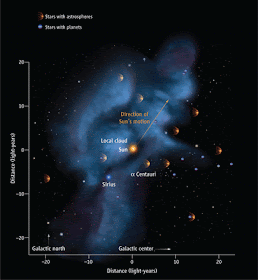by Salman Hameed
When talking about science & religion, people often bring up the big questions. How did the universe start? What is the origin of life, etc. And in these popular discussions, we often forget the beauty of actual science and the efforts that go in to figure out some of the answers. Our own perspectives about the universe have also changed dramatically in the last 100 years of astronomy.
I was thinking about this when I saw a schematic in this week's issue of Science (you will need subscription to read the full article). It shows our Sun's location in the neighborhood and the fact that it is traveling through a collection of interstellar clouds. Astronomers know this through the study of interstellar gas and dust near our heliosphere - the boundary where the outward pressure of the Solar wind is balanced by the inward pressure of the surrounding gas (other stars have it as well, but we call those astrospheres...). It is quite impressive that they have been able to map out the area in this detail. Also note that the schematic also has several nearby stars with planets! And to think that we discovered the first extrasolar planets only in the 1990s - this is quite awesome! Here is the figure along with the caption that goes with it:
And here is the bit about astrospheres around other stars:
No - we are not located at the center of the galaxy, nor are we part of some fancy spiral arm. We happen to be located about 30,000 light years from the center of the galaxy and part of an unremarkable piece of a spiral arm. At least it provides us with a humbling perspective. Enjoy!
When talking about science & religion, people often bring up the big questions. How did the universe start? What is the origin of life, etc. And in these popular discussions, we often forget the beauty of actual science and the efforts that go in to figure out some of the answers. Our own perspectives about the universe have also changed dramatically in the last 100 years of astronomy.
I was thinking about this when I saw a schematic in this week's issue of Science (you will need subscription to read the full article). It shows our Sun's location in the neighborhood and the fact that it is traveling through a collection of interstellar clouds. Astronomers know this through the study of interstellar gas and dust near our heliosphere - the boundary where the outward pressure of the Solar wind is balanced by the inward pressure of the surrounding gas (other stars have it as well, but we call those astrospheres...). It is quite impressive that they have been able to map out the area in this detail. Also note that the schematic also has several nearby stars with planets! And to think that we discovered the first extrasolar planets only in the 1990s - this is quite awesome! Here is the figure along with the caption that goes with it:
The Sun is traveling through a collection of interstellar clouds, the properties of which determine the structure of our heliosphere. As the Sun moves in and out of the clouds, the heliosphere expands and contracts. Analogous structures, astrospheres, have been detected around many nearby stars, as have exoplanetary systems.
And here is the bit about astrospheres around other stars:
Just like the heliosphere, these astrospheres are likely to encircle and protect planetary systems of their own. Within a radius of 20 light years, in which the nearest 100 stars reside, we know of 10 stars with astrospheres (including our nearest stellar neighbor, α Centauri) and 16 stars with detected planets in orbit around them (see the figure). We know of two stars with both, but given that detecting either astrospheres or planets around other stars has only recently become possible, our inventory is incomplete. As we gain a more detailed knowledge of our heliosphere and discover more astrospheres, exciting work will explore the relationship between a given planet and its heliospheric (or astrospheric) shield and the interstellar gas that surrounds them.But to get a broader perspective, here is our approximate location in the Milky Way galaxy:
No - we are not located at the center of the galaxy, nor are we part of some fancy spiral arm. We happen to be located about 30,000 light years from the center of the galaxy and part of an unremarkable piece of a spiral arm. At least it provides us with a humbling perspective. Enjoy!



No comments:
Post a Comment